Recording Business Transactions and Financial Statements Analysis
VerifiedAdded on 2023/01/03
|11
|2092
|92
Homework Assignment
AI Summary
This assignment provides a comprehensive overview of financial accounting, emphasizing the recording, analysis, and reporting of business transactions. It includes an introduction to financial accounting, highlighting the importance of financial statements like the balance sheet, income statement, and cash flow statement. The assignment explores the role of decision-makers and their need for accounting information, identifying various users such as management, shareholders, creditors, and government bodies. It also discusses the advantages and disadvantages of accounting, emphasizing its role in recording transactions, comparing results, and complying with statutory requirements. The assignment includes numerical examples of accounting transactions, ledger accounts, and a trial balance. Furthermore, it presents an income statement and analyzes the impact of COVID-19 on a company's financial performance, specifically addressing the decrease in sales, liquidity issues, and the influence of fixed expenses and government policies. The document concludes with a list of references used for research and analysis.
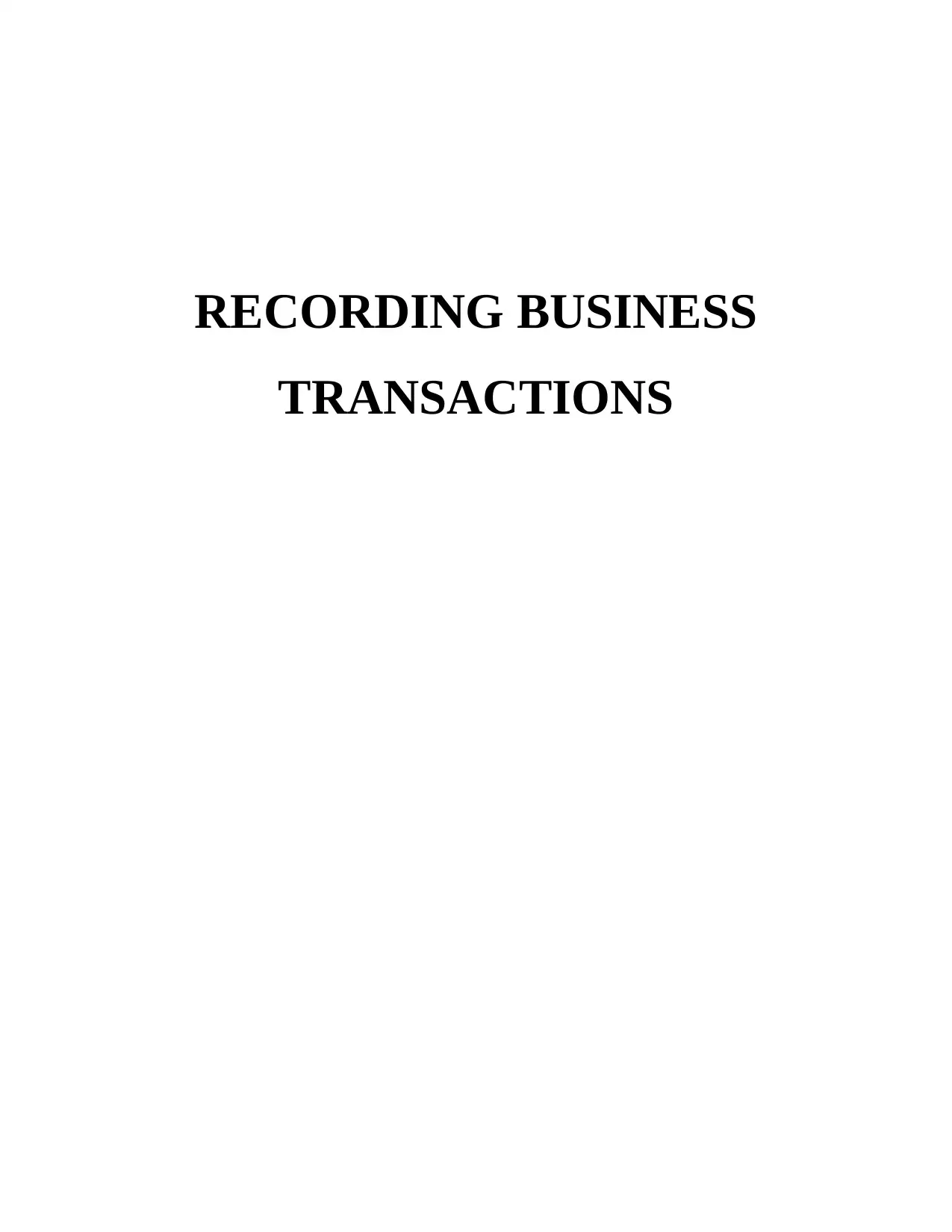
RECORDING BUSINESS
TRANSACTIONS
TRANSACTIONS
Paraphrase This Document
Need a fresh take? Get an instant paraphrase of this document with our AI Paraphraser
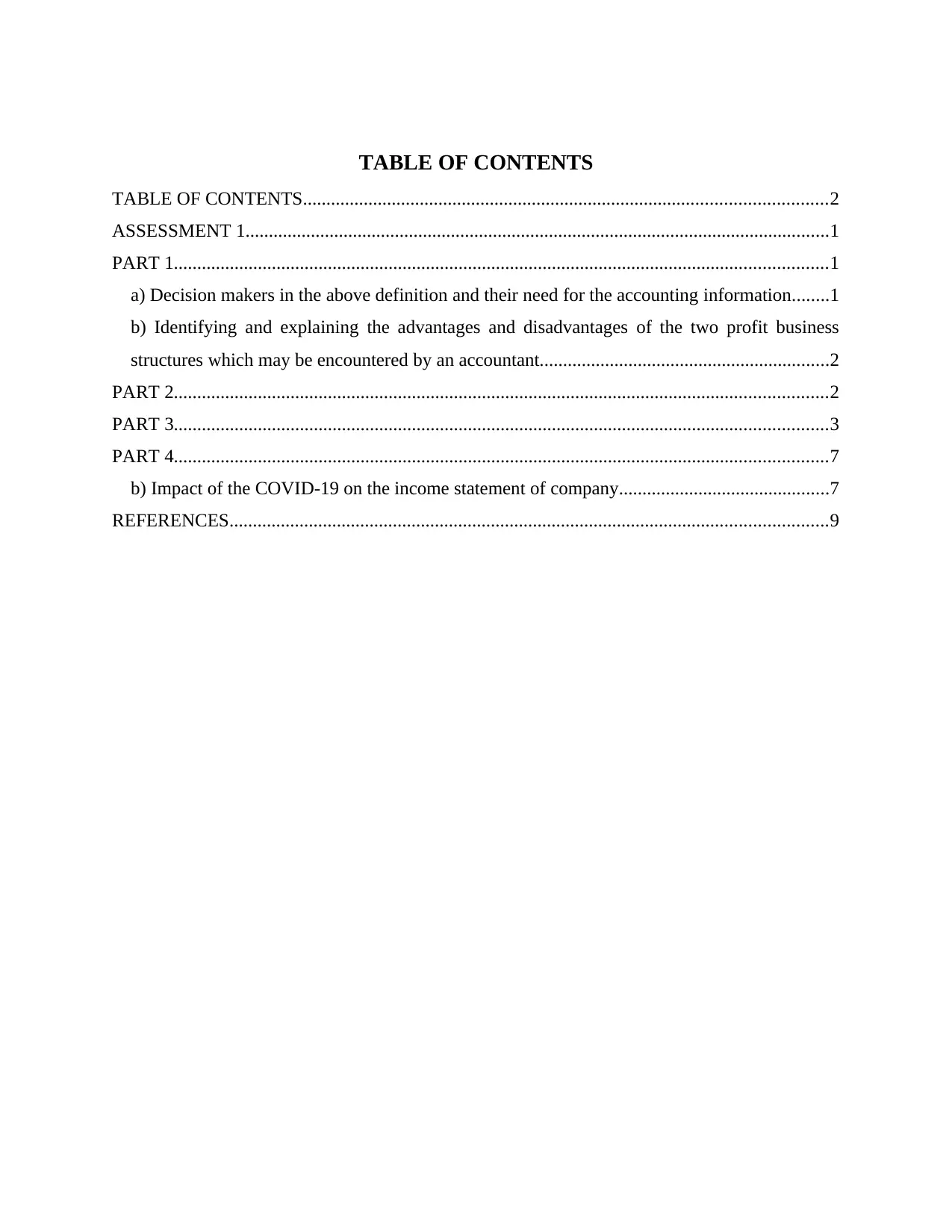
TABLE OF CONTENTS
TABLE OF CONTENTS................................................................................................................2
ASSESSMENT 1.............................................................................................................................1
PART 1............................................................................................................................................1
a) Decision makers in the above definition and their need for the accounting information........1
b) Identifying and explaining the advantages and disadvantages of the two profit business
structures which may be encountered by an accountant..............................................................2
PART 2............................................................................................................................................2
PART 3............................................................................................................................................3
PART 4............................................................................................................................................7
b) Impact of the COVID-19 on the income statement of company.............................................7
REFERENCES................................................................................................................................9
TABLE OF CONTENTS................................................................................................................2
ASSESSMENT 1.............................................................................................................................1
PART 1............................................................................................................................................1
a) Decision makers in the above definition and their need for the accounting information........1
b) Identifying and explaining the advantages and disadvantages of the two profit business
structures which may be encountered by an accountant..............................................................2
PART 2............................................................................................................................................2
PART 3............................................................................................................................................3
PART 4............................................................................................................................................7
b) Impact of the COVID-19 on the income statement of company.............................................7
REFERENCES................................................................................................................................9
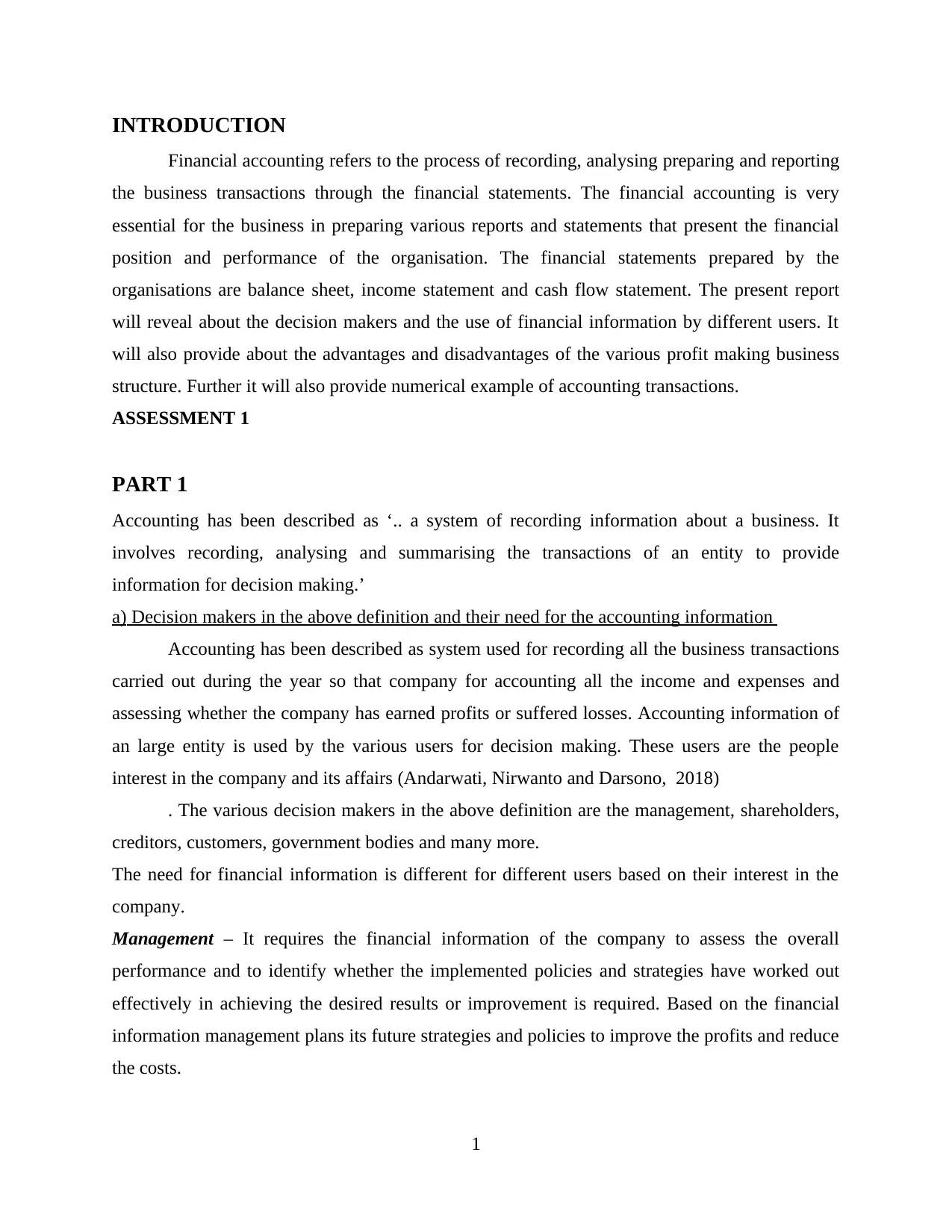
INTRODUCTION
Financial accounting refers to the process of recording, analysing preparing and reporting
the business transactions through the financial statements. The financial accounting is very
essential for the business in preparing various reports and statements that present the financial
position and performance of the organisation. The financial statements prepared by the
organisations are balance sheet, income statement and cash flow statement. The present report
will reveal about the decision makers and the use of financial information by different users. It
will also provide about the advantages and disadvantages of the various profit making business
structure. Further it will also provide numerical example of accounting transactions.
ASSESSMENT 1
PART 1
Accounting has been described as ‘.. a system of recording information about a business. It
involves recording, analysing and summarising the transactions of an entity to provide
information for decision making.’
a) Decision makers in the above definition and their need for the accounting information
Accounting has been described as system used for recording all the business transactions
carried out during the year so that company for accounting all the income and expenses and
assessing whether the company has earned profits or suffered losses. Accounting information of
an large entity is used by the various users for decision making. These users are the people
interest in the company and its affairs (Andarwati, Nirwanto and Darsono, 2018)
. The various decision makers in the above definition are the management, shareholders,
creditors, customers, government bodies and many more.
The need for financial information is different for different users based on their interest in the
company.
Management – It requires the financial information of the company to assess the overall
performance and to identify whether the implemented policies and strategies have worked out
effectively in achieving the desired results or improvement is required. Based on the financial
information management plans its future strategies and policies to improve the profits and reduce
the costs.
1
Financial accounting refers to the process of recording, analysing preparing and reporting
the business transactions through the financial statements. The financial accounting is very
essential for the business in preparing various reports and statements that present the financial
position and performance of the organisation. The financial statements prepared by the
organisations are balance sheet, income statement and cash flow statement. The present report
will reveal about the decision makers and the use of financial information by different users. It
will also provide about the advantages and disadvantages of the various profit making business
structure. Further it will also provide numerical example of accounting transactions.
ASSESSMENT 1
PART 1
Accounting has been described as ‘.. a system of recording information about a business. It
involves recording, analysing and summarising the transactions of an entity to provide
information for decision making.’
a) Decision makers in the above definition and their need for the accounting information
Accounting has been described as system used for recording all the business transactions
carried out during the year so that company for accounting all the income and expenses and
assessing whether the company has earned profits or suffered losses. Accounting information of
an large entity is used by the various users for decision making. These users are the people
interest in the company and its affairs (Andarwati, Nirwanto and Darsono, 2018)
. The various decision makers in the above definition are the management, shareholders,
creditors, customers, government bodies and many more.
The need for financial information is different for different users based on their interest in the
company.
Management – It requires the financial information of the company to assess the overall
performance and to identify whether the implemented policies and strategies have worked out
effectively in achieving the desired results or improvement is required. Based on the financial
information management plans its future strategies and policies to improve the profits and reduce
the costs.
1
⊘ This is a preview!⊘
Do you want full access?
Subscribe today to unlock all pages.

Trusted by 1+ million students worldwide
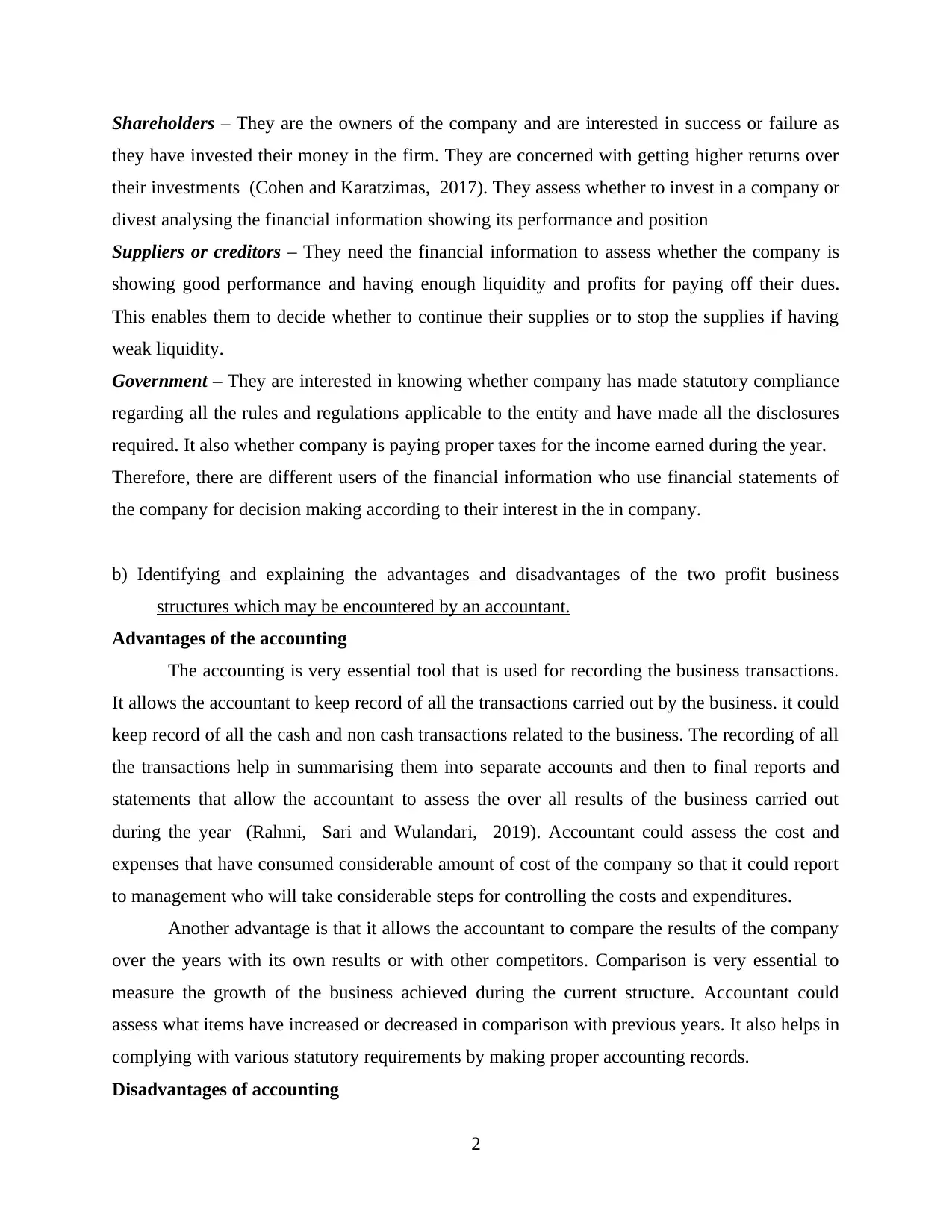
Shareholders – They are the owners of the company and are interested in success or failure as
they have invested their money in the firm. They are concerned with getting higher returns over
their investments (Cohen and Karatzimas, 2017). They assess whether to invest in a company or
divest analysing the financial information showing its performance and position
Suppliers or creditors – They need the financial information to assess whether the company is
showing good performance and having enough liquidity and profits for paying off their dues.
This enables them to decide whether to continue their supplies or to stop the supplies if having
weak liquidity.
Government – They are interested in knowing whether company has made statutory compliance
regarding all the rules and regulations applicable to the entity and have made all the disclosures
required. It also whether company is paying proper taxes for the income earned during the year.
Therefore, there are different users of the financial information who use financial statements of
the company for decision making according to their interest in the in company.
b) Identifying and explaining the advantages and disadvantages of the two profit business
structures which may be encountered by an accountant.
Advantages of the accounting
The accounting is very essential tool that is used for recording the business transactions.
It allows the accountant to keep record of all the transactions carried out by the business. it could
keep record of all the cash and non cash transactions related to the business. The recording of all
the transactions help in summarising them into separate accounts and then to final reports and
statements that allow the accountant to assess the over all results of the business carried out
during the year (Rahmi, Sari and Wulandari, 2019). Accountant could assess the cost and
expenses that have consumed considerable amount of cost of the company so that it could report
to management who will take considerable steps for controlling the costs and expenditures.
Another advantage is that it allows the accountant to compare the results of the company
over the years with its own results or with other competitors. Comparison is very essential to
measure the growth of the business achieved during the current structure. Accountant could
assess what items have increased or decreased in comparison with previous years. It also helps in
complying with various statutory requirements by making proper accounting records.
Disadvantages of accounting
2
they have invested their money in the firm. They are concerned with getting higher returns over
their investments (Cohen and Karatzimas, 2017). They assess whether to invest in a company or
divest analysing the financial information showing its performance and position
Suppliers or creditors – They need the financial information to assess whether the company is
showing good performance and having enough liquidity and profits for paying off their dues.
This enables them to decide whether to continue their supplies or to stop the supplies if having
weak liquidity.
Government – They are interested in knowing whether company has made statutory compliance
regarding all the rules and regulations applicable to the entity and have made all the disclosures
required. It also whether company is paying proper taxes for the income earned during the year.
Therefore, there are different users of the financial information who use financial statements of
the company for decision making according to their interest in the in company.
b) Identifying and explaining the advantages and disadvantages of the two profit business
structures which may be encountered by an accountant.
Advantages of the accounting
The accounting is very essential tool that is used for recording the business transactions.
It allows the accountant to keep record of all the transactions carried out by the business. it could
keep record of all the cash and non cash transactions related to the business. The recording of all
the transactions help in summarising them into separate accounts and then to final reports and
statements that allow the accountant to assess the over all results of the business carried out
during the year (Rahmi, Sari and Wulandari, 2019). Accountant could assess the cost and
expenses that have consumed considerable amount of cost of the company so that it could report
to management who will take considerable steps for controlling the costs and expenditures.
Another advantage is that it allows the accountant to compare the results of the company
over the years with its own results or with other competitors. Comparison is very essential to
measure the growth of the business achieved during the current structure. Accountant could
assess what items have increased or decreased in comparison with previous years. It also helps in
complying with various statutory requirements by making proper accounting records.
Disadvantages of accounting
2
Paraphrase This Document
Need a fresh take? Get an instant paraphrase of this document with our AI Paraphraser
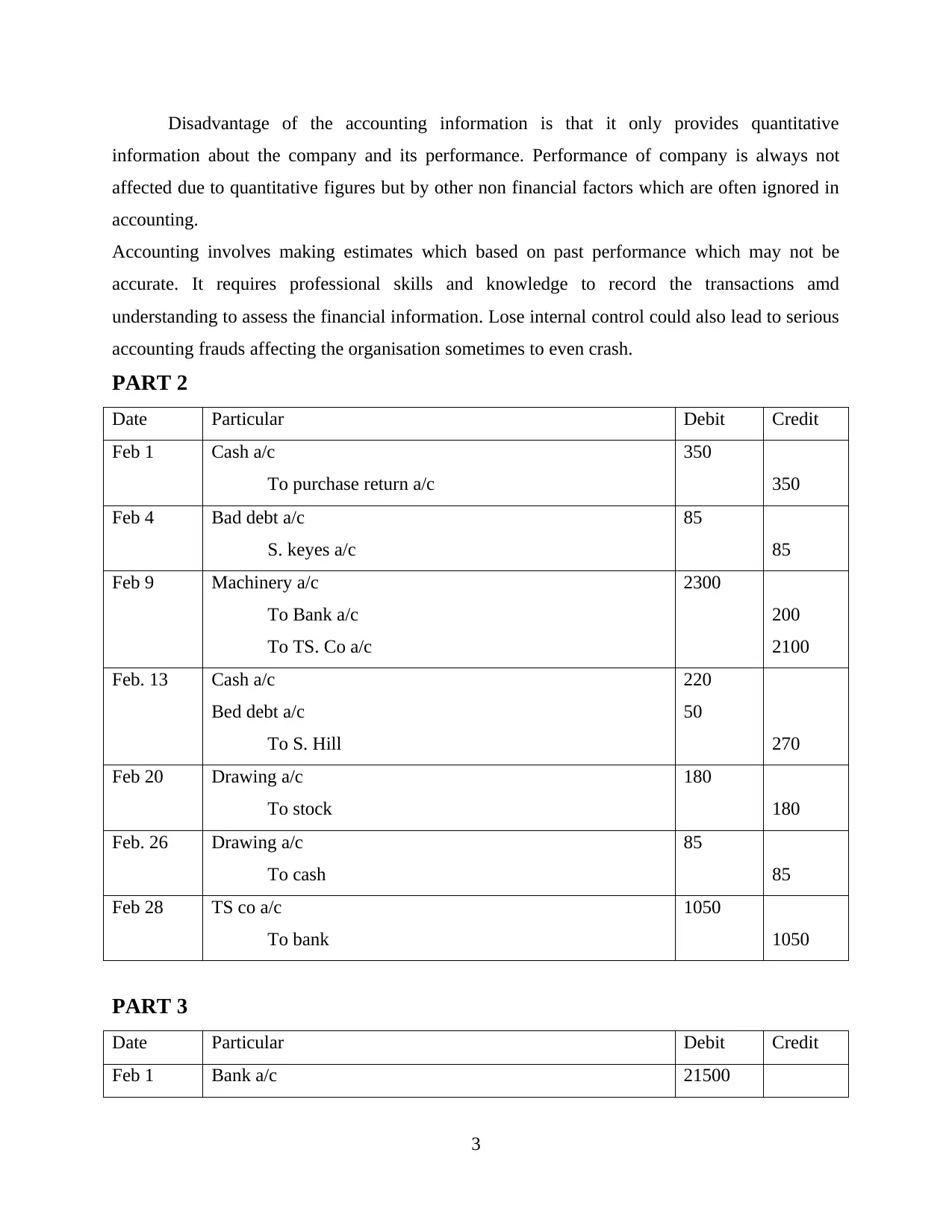
Disadvantage of the accounting information is that it only provides quantitative
information about the company and its performance. Performance of company is always not
affected due to quantitative figures but by other non financial factors which are often ignored in
accounting.
Accounting involves making estimates which based on past performance which may not be
accurate. It requires professional skills and knowledge to record the transactions amd
understanding to assess the financial information. Lose internal control could also lead to serious
accounting frauds affecting the organisation sometimes to even crash.
PART 2
Date Particular Debit Credit
Feb 1 Cash a/c
To purchase return a/c
350
350
Feb 4 Bad debt a/c
S. keyes a/c
85
85
Feb 9 Machinery a/c
To Bank a/c
To TS. Co a/c
2300
200
2100
Feb. 13 Cash a/c
Bed debt a/c
To S. Hill
220
50
270
Feb 20 Drawing a/c
To stock
180
180
Feb. 26 Drawing a/c
To cash
85
85
Feb 28 TS co a/c
To bank
1050
1050
PART 3
Date Particular Debit Credit
Feb 1 Bank a/c 21500
3
information about the company and its performance. Performance of company is always not
affected due to quantitative figures but by other non financial factors which are often ignored in
accounting.
Accounting involves making estimates which based on past performance which may not be
accurate. It requires professional skills and knowledge to record the transactions amd
understanding to assess the financial information. Lose internal control could also lead to serious
accounting frauds affecting the organisation sometimes to even crash.
PART 2
Date Particular Debit Credit
Feb 1 Cash a/c
To purchase return a/c
350
350
Feb 4 Bad debt a/c
S. keyes a/c
85
85
Feb 9 Machinery a/c
To Bank a/c
To TS. Co a/c
2300
200
2100
Feb. 13 Cash a/c
Bed debt a/c
To S. Hill
220
50
270
Feb 20 Drawing a/c
To stock
180
180
Feb. 26 Drawing a/c
To cash
85
85
Feb 28 TS co a/c
To bank
1050
1050
PART 3
Date Particular Debit Credit
Feb 1 Bank a/c 21500
3
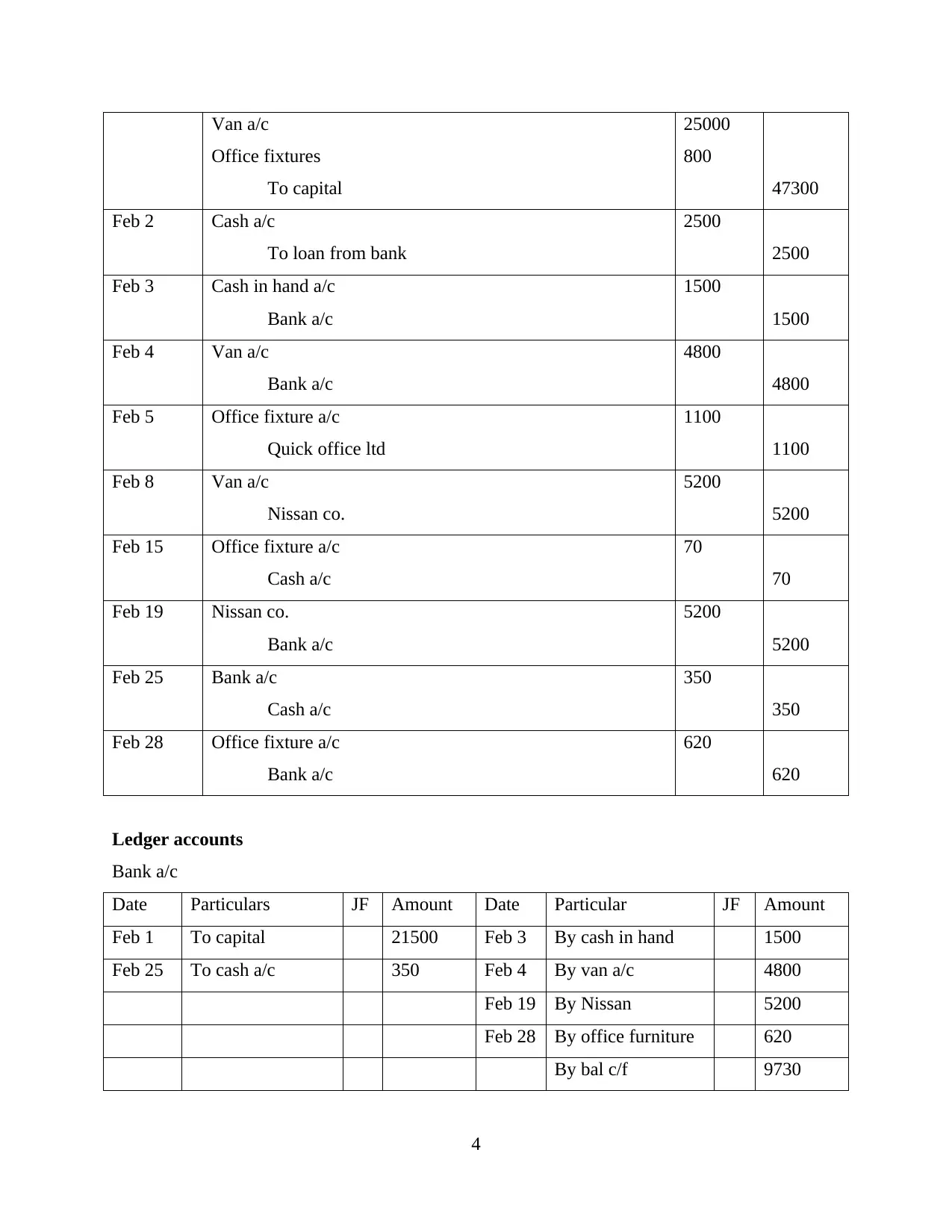
Van a/c
Office fixtures
To capital
25000
800
47300
Feb 2 Cash a/c
To loan from bank
2500
2500
Feb 3 Cash in hand a/c
Bank a/c
1500
1500
Feb 4 Van a/c
Bank a/c
4800
4800
Feb 5 Office fixture a/c
Quick office ltd
1100
1100
Feb 8 Van a/c
Nissan co.
5200
5200
Feb 15 Office fixture a/c
Cash a/c
70
70
Feb 19 Nissan co.
Bank a/c
5200
5200
Feb 25 Bank a/c
Cash a/c
350
350
Feb 28 Office fixture a/c
Bank a/c
620
620
Ledger accounts
Bank a/c
Date Particulars JF Amount Date Particular JF Amount
Feb 1 To capital 21500 Feb 3 By cash in hand 1500
Feb 25 To cash a/c 350 Feb 4 By van a/c 4800
Feb 19 By Nissan 5200
Feb 28 By office furniture 620
By bal c/f 9730
4
Office fixtures
To capital
25000
800
47300
Feb 2 Cash a/c
To loan from bank
2500
2500
Feb 3 Cash in hand a/c
Bank a/c
1500
1500
Feb 4 Van a/c
Bank a/c
4800
4800
Feb 5 Office fixture a/c
Quick office ltd
1100
1100
Feb 8 Van a/c
Nissan co.
5200
5200
Feb 15 Office fixture a/c
Cash a/c
70
70
Feb 19 Nissan co.
Bank a/c
5200
5200
Feb 25 Bank a/c
Cash a/c
350
350
Feb 28 Office fixture a/c
Bank a/c
620
620
Ledger accounts
Bank a/c
Date Particulars JF Amount Date Particular JF Amount
Feb 1 To capital 21500 Feb 3 By cash in hand 1500
Feb 25 To cash a/c 350 Feb 4 By van a/c 4800
Feb 19 By Nissan 5200
Feb 28 By office furniture 620
By bal c/f 9730
4
⊘ This is a preview!⊘
Do you want full access?
Subscribe today to unlock all pages.

Trusted by 1+ million students worldwide
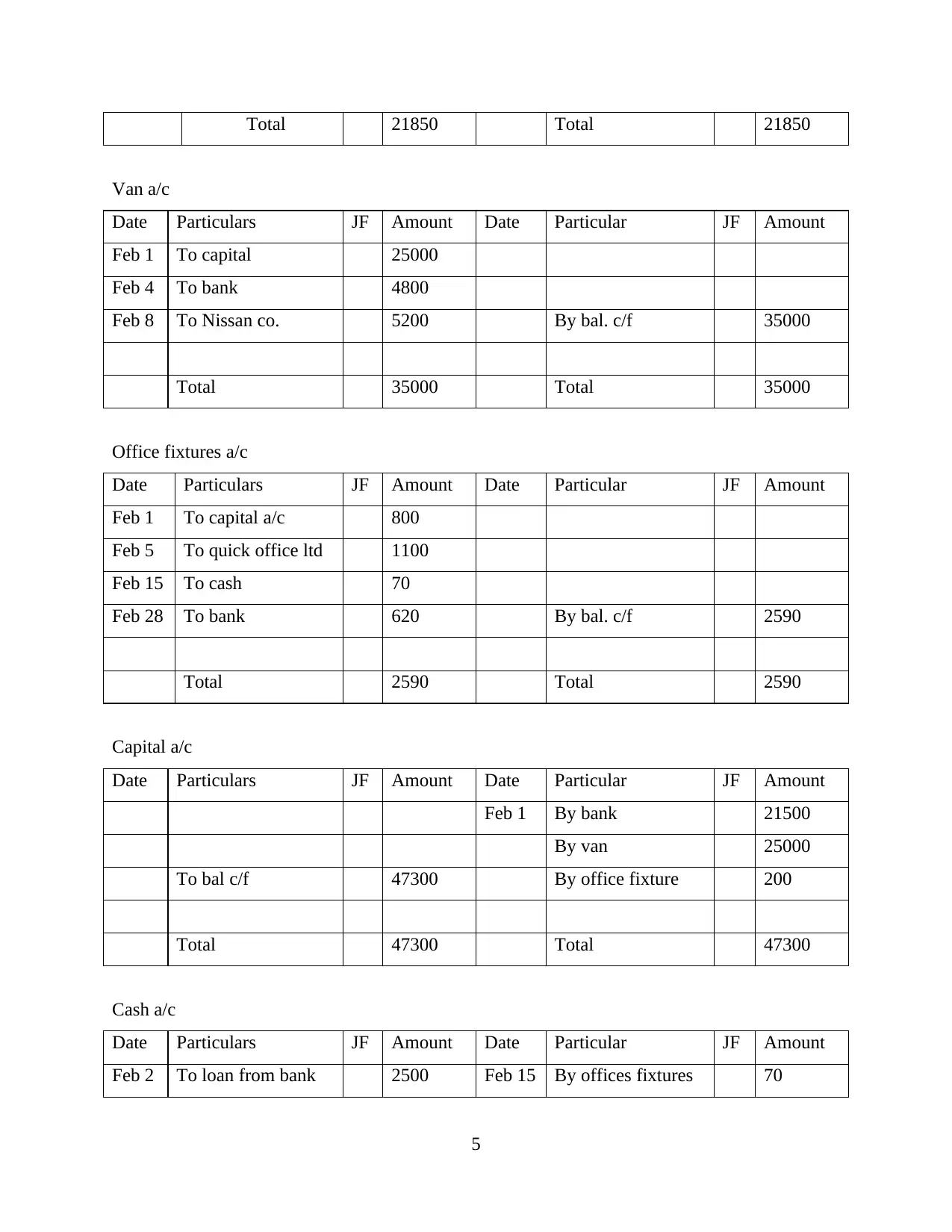
Total 21850 Total 21850
Van a/c
Date Particulars JF Amount Date Particular JF Amount
Feb 1 To capital 25000
Feb 4 To bank 4800
Feb 8 To Nissan co. 5200 By bal. c/f 35000
Total 35000 Total 35000
Office fixtures a/c
Date Particulars JF Amount Date Particular JF Amount
Feb 1 To capital a/c 800
Feb 5 To quick office ltd 1100
Feb 15 To cash 70
Feb 28 To bank 620 By bal. c/f 2590
Total 2590 Total 2590
Capital a/c
Date Particulars JF Amount Date Particular JF Amount
Feb 1 By bank 21500
By van 25000
To bal c/f 47300 By office fixture 200
Total 47300 Total 47300
Cash a/c
Date Particulars JF Amount Date Particular JF Amount
Feb 2 To loan from bank 2500 Feb 15 By offices fixtures 70
5
Van a/c
Date Particulars JF Amount Date Particular JF Amount
Feb 1 To capital 25000
Feb 4 To bank 4800
Feb 8 To Nissan co. 5200 By bal. c/f 35000
Total 35000 Total 35000
Office fixtures a/c
Date Particulars JF Amount Date Particular JF Amount
Feb 1 To capital a/c 800
Feb 5 To quick office ltd 1100
Feb 15 To cash 70
Feb 28 To bank 620 By bal. c/f 2590
Total 2590 Total 2590
Capital a/c
Date Particulars JF Amount Date Particular JF Amount
Feb 1 By bank 21500
By van 25000
To bal c/f 47300 By office fixture 200
Total 47300 Total 47300
Cash a/c
Date Particulars JF Amount Date Particular JF Amount
Feb 2 To loan from bank 2500 Feb 15 By offices fixtures 70
5
Paraphrase This Document
Need a fresh take? Get an instant paraphrase of this document with our AI Paraphraser
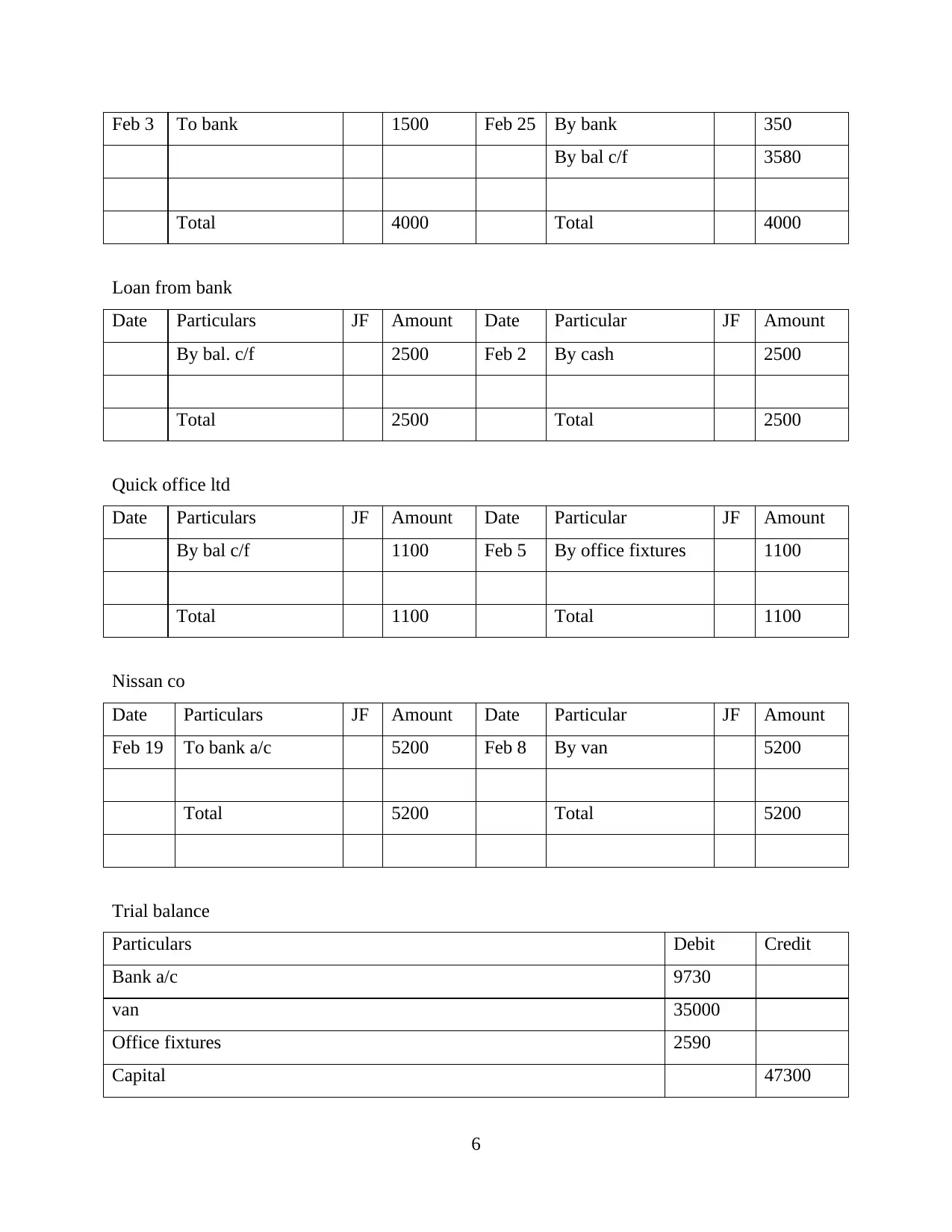
Feb 3 To bank 1500 Feb 25 By bank 350
By bal c/f 3580
Total 4000 Total 4000
Loan from bank
Date Particulars JF Amount Date Particular JF Amount
By bal. c/f 2500 Feb 2 By cash 2500
Total 2500 Total 2500
Quick office ltd
Date Particulars JF Amount Date Particular JF Amount
By bal c/f 1100 Feb 5 By office fixtures 1100
Total 1100 Total 1100
Nissan co
Date Particulars JF Amount Date Particular JF Amount
Feb 19 To bank a/c 5200 Feb 8 By van 5200
Total 5200 Total 5200
Trial balance
Particulars Debit Credit
Bank a/c 9730
van 35000
Office fixtures 2590
Capital 47300
6
By bal c/f 3580
Total 4000 Total 4000
Loan from bank
Date Particulars JF Amount Date Particular JF Amount
By bal. c/f 2500 Feb 2 By cash 2500
Total 2500 Total 2500
Quick office ltd
Date Particulars JF Amount Date Particular JF Amount
By bal c/f 1100 Feb 5 By office fixtures 1100
Total 1100 Total 1100
Nissan co
Date Particulars JF Amount Date Particular JF Amount
Feb 19 To bank a/c 5200 Feb 8 By van 5200
Total 5200 Total 5200
Trial balance
Particulars Debit Credit
Bank a/c 9730
van 35000
Office fixtures 2590
Capital 47300
6
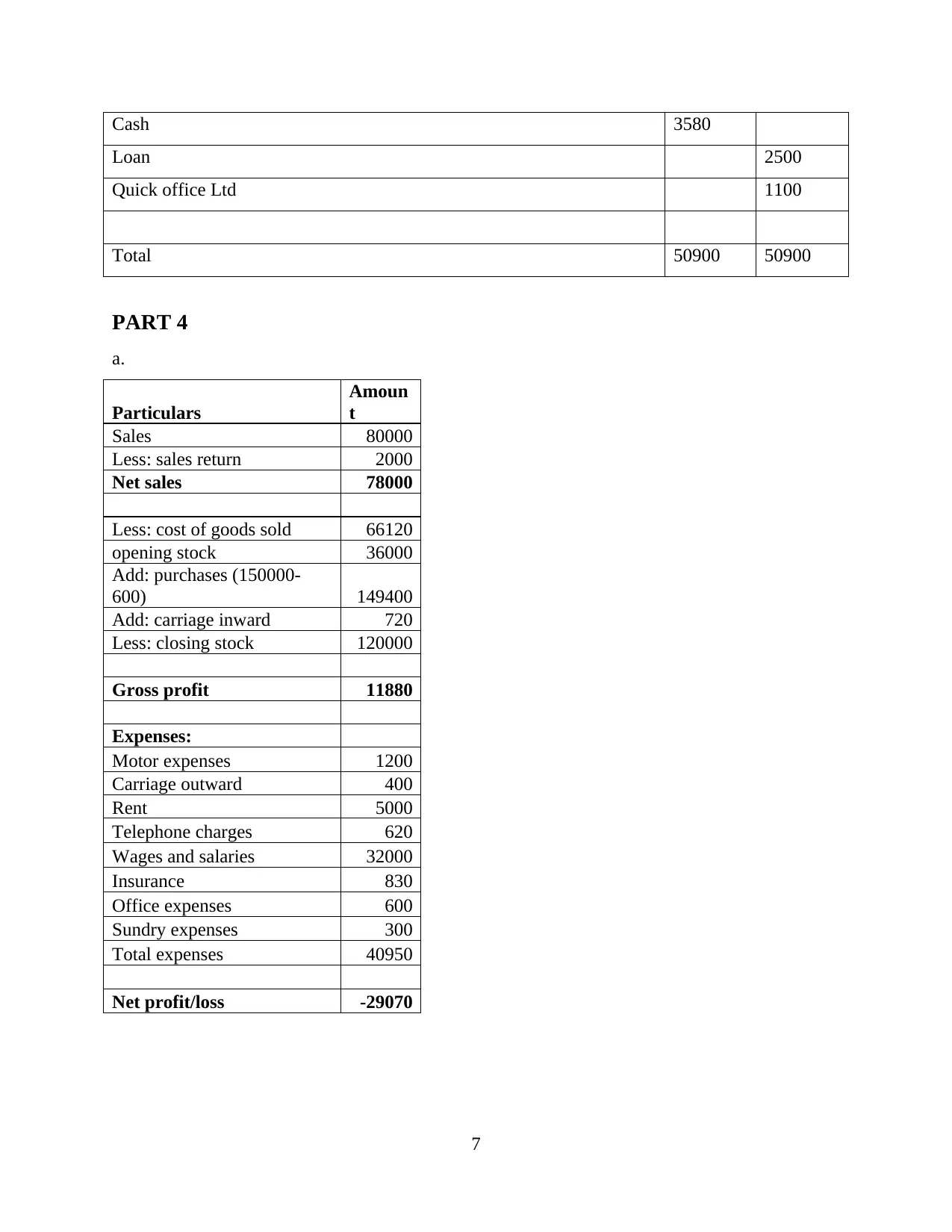
Cash 3580
Loan 2500
Quick office Ltd 1100
Total 50900 50900
PART 4
a.
Particulars
Amoun
t
Sales 80000
Less: sales return 2000
Net sales 78000
Less: cost of goods sold 66120
opening stock 36000
Add: purchases (150000-
600) 149400
Add: carriage inward 720
Less: closing stock 120000
Gross profit 11880
Expenses:
Motor expenses 1200
Carriage outward 400
Rent 5000
Telephone charges 620
Wages and salaries 32000
Insurance 830
Office expenses 600
Sundry expenses 300
Total expenses 40950
Net profit/loss -29070
7
Loan 2500
Quick office Ltd 1100
Total 50900 50900
PART 4
a.
Particulars
Amoun
t
Sales 80000
Less: sales return 2000
Net sales 78000
Less: cost of goods sold 66120
opening stock 36000
Add: purchases (150000-
600) 149400
Add: carriage inward 720
Less: closing stock 120000
Gross profit 11880
Expenses:
Motor expenses 1200
Carriage outward 400
Rent 5000
Telephone charges 620
Wages and salaries 32000
Insurance 830
Office expenses 600
Sundry expenses 300
Total expenses 40950
Net profit/loss -29070
7
⊘ This is a preview!⊘
Do you want full access?
Subscribe today to unlock all pages.

Trusted by 1+ million students worldwide
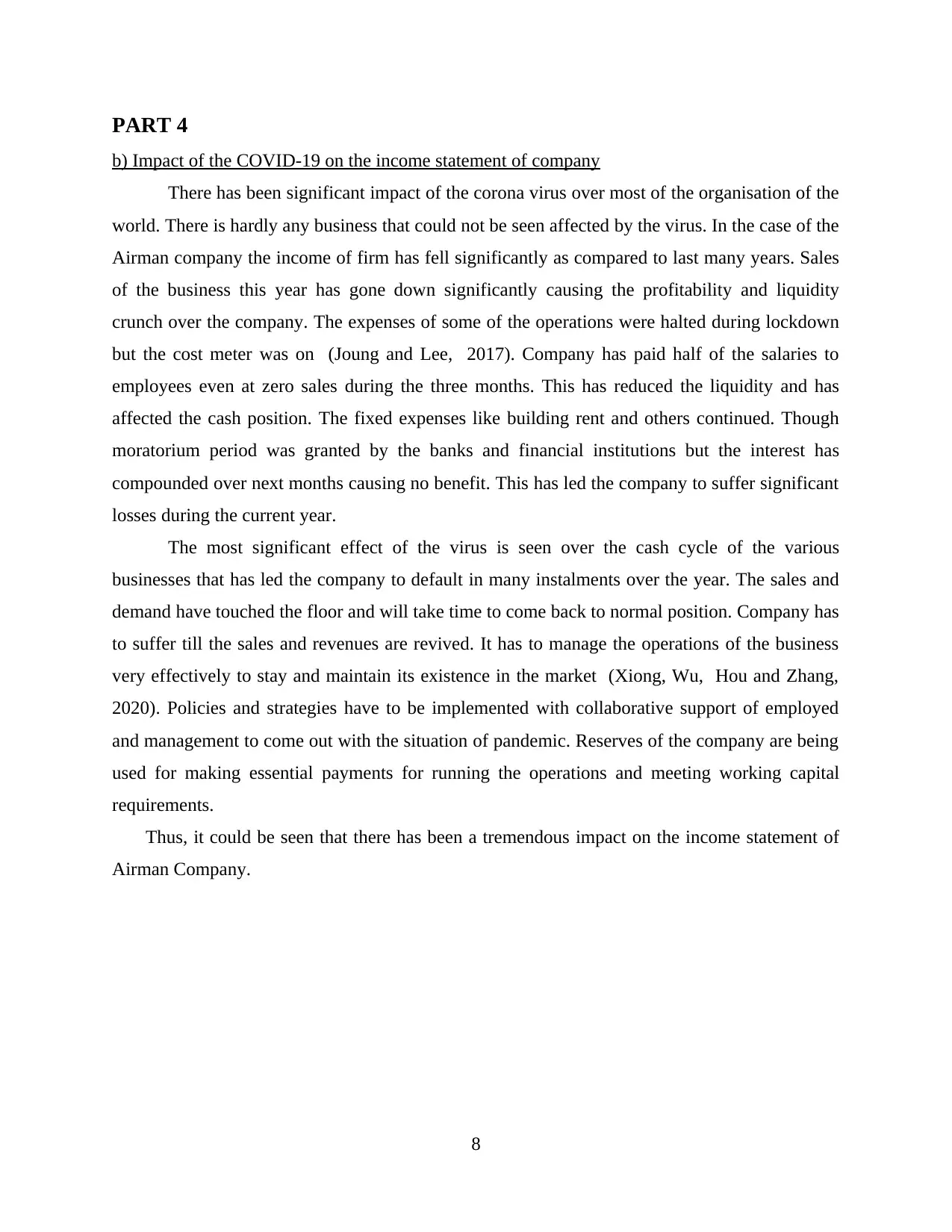
PART 4
b) Impact of the COVID-19 on the income statement of company
There has been significant impact of the corona virus over most of the organisation of the
world. There is hardly any business that could not be seen affected by the virus. In the case of the
Airman company the income of firm has fell significantly as compared to last many years. Sales
of the business this year has gone down significantly causing the profitability and liquidity
crunch over the company. The expenses of some of the operations were halted during lockdown
but the cost meter was on (Joung and Lee, 2017). Company has paid half of the salaries to
employees even at zero sales during the three months. This has reduced the liquidity and has
affected the cash position. The fixed expenses like building rent and others continued. Though
moratorium period was granted by the banks and financial institutions but the interest has
compounded over next months causing no benefit. This has led the company to suffer significant
losses during the current year.
The most significant effect of the virus is seen over the cash cycle of the various
businesses that has led the company to default in many instalments over the year. The sales and
demand have touched the floor and will take time to come back to normal position. Company has
to suffer till the sales and revenues are revived. It has to manage the operations of the business
very effectively to stay and maintain its existence in the market (Xiong, Wu, Hou and Zhang,
2020). Policies and strategies have to be implemented with collaborative support of employed
and management to come out with the situation of pandemic. Reserves of the company are being
used for making essential payments for running the operations and meeting working capital
requirements.
Thus, it could be seen that there has been a tremendous impact on the income statement of
Airman Company.
8
b) Impact of the COVID-19 on the income statement of company
There has been significant impact of the corona virus over most of the organisation of the
world. There is hardly any business that could not be seen affected by the virus. In the case of the
Airman company the income of firm has fell significantly as compared to last many years. Sales
of the business this year has gone down significantly causing the profitability and liquidity
crunch over the company. The expenses of some of the operations were halted during lockdown
but the cost meter was on (Joung and Lee, 2017). Company has paid half of the salaries to
employees even at zero sales during the three months. This has reduced the liquidity and has
affected the cash position. The fixed expenses like building rent and others continued. Though
moratorium period was granted by the banks and financial institutions but the interest has
compounded over next months causing no benefit. This has led the company to suffer significant
losses during the current year.
The most significant effect of the virus is seen over the cash cycle of the various
businesses that has led the company to default in many instalments over the year. The sales and
demand have touched the floor and will take time to come back to normal position. Company has
to suffer till the sales and revenues are revived. It has to manage the operations of the business
very effectively to stay and maintain its existence in the market (Xiong, Wu, Hou and Zhang,
2020). Policies and strategies have to be implemented with collaborative support of employed
and management to come out with the situation of pandemic. Reserves of the company are being
used for making essential payments for running the operations and meeting working capital
requirements.
Thus, it could be seen that there has been a tremendous impact on the income statement of
Airman Company.
8
Paraphrase This Document
Need a fresh take? Get an instant paraphrase of this document with our AI Paraphraser
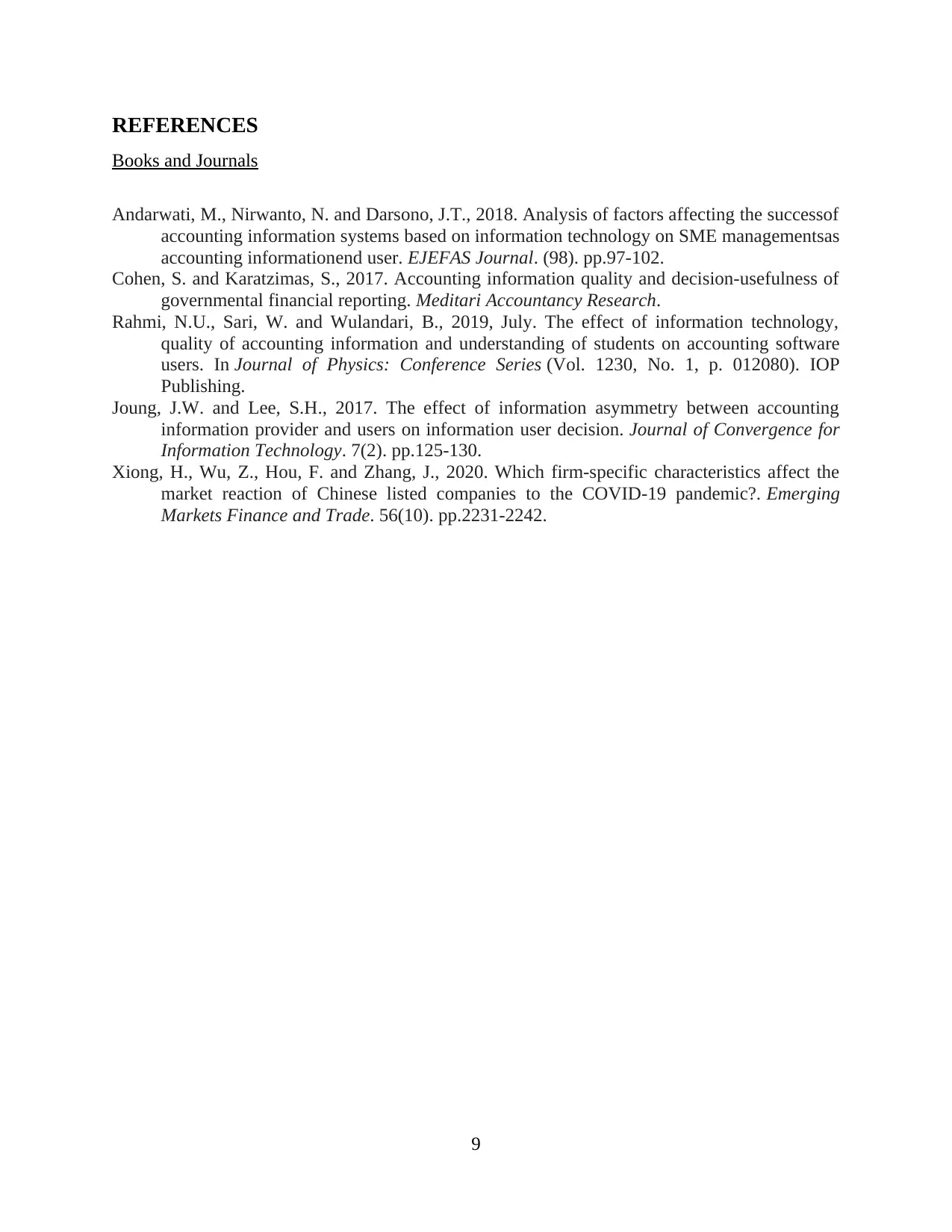
REFERENCES
Books and Journals
Andarwati, M., Nirwanto, N. and Darsono, J.T., 2018. Analysis of factors affecting the successof
accounting information systems based on information technology on SME managementsas
accounting informationend user. EJEFAS Journal. (98). pp.97-102.
Cohen, S. and Karatzimas, S., 2017. Accounting information quality and decision-usefulness of
governmental financial reporting. Meditari Accountancy Research.
Rahmi, N.U., Sari, W. and Wulandari, B., 2019, July. The effect of information technology,
quality of accounting information and understanding of students on accounting software
users. In Journal of Physics: Conference Series (Vol. 1230, No. 1, p. 012080). IOP
Publishing.
Joung, J.W. and Lee, S.H., 2017. The effect of information asymmetry between accounting
information provider and users on information user decision. Journal of Convergence for
Information Technology. 7(2). pp.125-130.
Xiong, H., Wu, Z., Hou, F. and Zhang, J., 2020. Which firm-specific characteristics affect the
market reaction of Chinese listed companies to the COVID-19 pandemic?. Emerging
Markets Finance and Trade. 56(10). pp.2231-2242.
9
Books and Journals
Andarwati, M., Nirwanto, N. and Darsono, J.T., 2018. Analysis of factors affecting the successof
accounting information systems based on information technology on SME managementsas
accounting informationend user. EJEFAS Journal. (98). pp.97-102.
Cohen, S. and Karatzimas, S., 2017. Accounting information quality and decision-usefulness of
governmental financial reporting. Meditari Accountancy Research.
Rahmi, N.U., Sari, W. and Wulandari, B., 2019, July. The effect of information technology,
quality of accounting information and understanding of students on accounting software
users. In Journal of Physics: Conference Series (Vol. 1230, No. 1, p. 012080). IOP
Publishing.
Joung, J.W. and Lee, S.H., 2017. The effect of information asymmetry between accounting
information provider and users on information user decision. Journal of Convergence for
Information Technology. 7(2). pp.125-130.
Xiong, H., Wu, Z., Hou, F. and Zhang, J., 2020. Which firm-specific characteristics affect the
market reaction of Chinese listed companies to the COVID-19 pandemic?. Emerging
Markets Finance and Trade. 56(10). pp.2231-2242.
9
1 out of 11
Related Documents
Your All-in-One AI-Powered Toolkit for Academic Success.
+13062052269
info@desklib.com
Available 24*7 on WhatsApp / Email
![[object Object]](/_next/static/media/star-bottom.7253800d.svg)
Unlock your academic potential
Copyright © 2020–2025 A2Z Services. All Rights Reserved. Developed and managed by ZUCOL.





